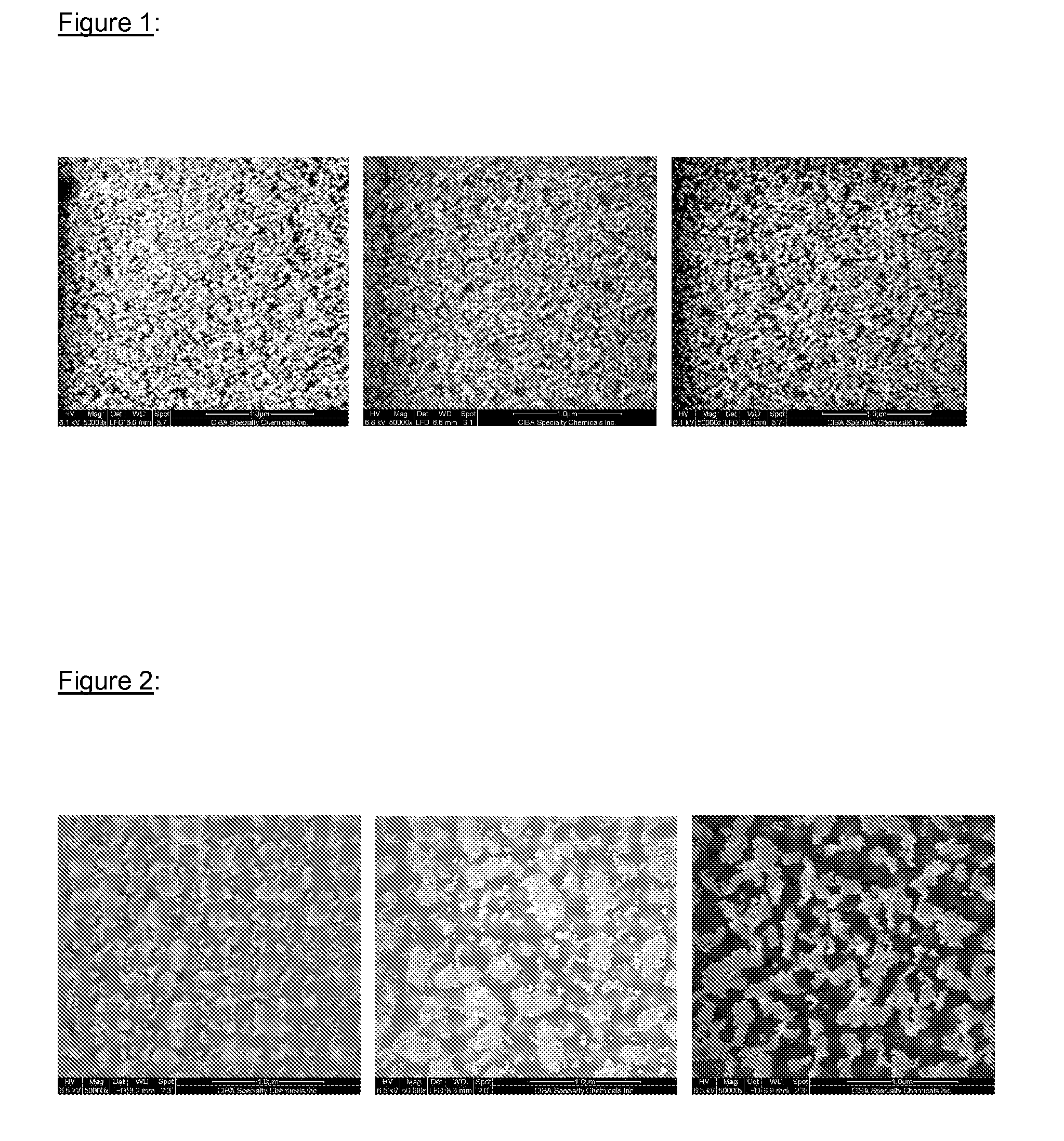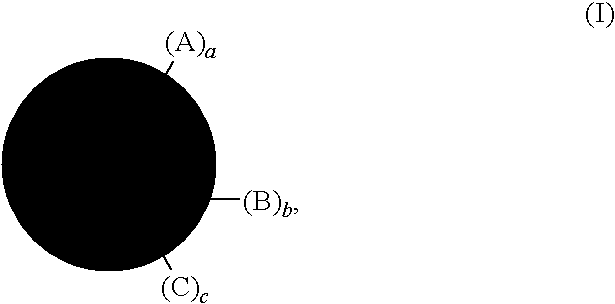Changing surface properties by functionalized nanoparticles
a technology of functionalized nanoparticles and surface properties, which is applied in the field of surface modification of substrates with functionalized nanoparticles, can solve the problems of not being suitable for industrial applications having high throughput rates, not being very efficient, and requiring vacuum apparatuses for vapour deposition
- Summary
- Abstract
- Description
- Claims
- Application Information
AI Technical Summary
Benefits of technology
Problems solved by technology
Method used
Image
Examples
example 1
Modified Silica Nanoparticles with Allylether and MPEG(3) Groups
[0352]
[0353]50 g of an aminopropyl modified silica nanoparticle dispersion 27.1 wt. % in EtOH (see Ex. 1 of WO 06 / 045713; solid content: 13.55 g; nitrogen content: 64.6 mmol) is mixed with 9.08 g (38.8 mmol) of glycidyl-triethyleneglycol-monomethylether [made from triethyleneglycol monomethylether (Fluka purum) with 5× excess of epichlorohydrine (Fluka purum) in 50% NaOH and azeotropic distillation of H2O / epichlorohydrine at 50° C., 3 h, p=95 mbar; epoxy-content: 4.27 meq / g] and 2.94 g (25.8 mmol) allyl-glycidylether (Fluke, purum) and stirred at 50° C. for 18 h. The solvent (EtOH) is evaporated in the rotary evaporator to obtain 24.51 g of a colorless liquid, which is re-dispersed in isopropanol to obtain a 25.0 wt. % dispersion.
Analytics:
[0354]1H-NMR confirms the structure and shows a ratio of MPEG / allylether of 60 / 40.
[0355]Thermogravimetric analysis (TGA; heating rate: 10° C. / min from 50° C. to 800° C.): Weight loss:...
example 2
Modified Silica Nanoparticles with “Zwitterionic” (=Betaine) Groups
[0357]
[0358]50 g of an aminopropyl modified silica nanoparticle dispersion 27.1 wt. % in EtOH (see Ex. 1 in WO 06 / 045713; solid content: 13.55 g; nitrogen content: 64.6 mmol) is mixed with 7.56 g (32.3 mmol) glycidyl-triethyleneglycol-monomethylether (see Ex. 1) and 3.68 g (32.3 mmol) allyl-glycidylether (Fluke, purum) and stirred at 50° C. for 18 h. The solvent (EtOH) is evaporated in the rotary evaporator and the residue dispersed in 150 ml acetone. 7.89 g (64.6 mmol) 1,3-propanesulfone (Fluke purum) is added and the mixture stirred for 18 h at 50° C., whereby a brownish precipitate is formed. After evaporation of all solvent in the rotavap, 32.6 g of a brown resin is obtained, which is re-dispersed in water / isopropanol (80 / 20 v / v) to obtain a 25.0 wt. % dispersion.
Analytics:
[0359]1H-NMR confirms the structure and shows a ratio of MPEG / allylether of 50 / 50.
[0360]Thermogravimetric analysis (TGA; heating rate: 10° C. / ...
example 3
Modified Silica Nanoparticles with Allylether and Trimethyl-Ammonium Chloride Groups
[0362]
[0363]50 g of an aminopropyl modified silica nanoparticle dispersion 27.1 wt. % in EtOH (see Ex. 1 in WO 06 / 045713; solid content: 13.55 g; nitrogen content: 64.6 mmol) is mixed with 10.38 g of a aqueous solution (80%; dry weight: 8.31 g=43.07 mmol) of an ammoniumethyl acrylate (Ageflex® FA1Q80MC, Ciba Specialty Chemicals), diluted with 20 ml EtOH and stirred at 50° C. for 18 h. 2.45 g (21.53 mmol) allyl-glycidylether (Fluke, purum) is added and stirring at 50° C. continued for another 8 h. The solvent (EtOH) is evaporated in the rotary evaporator and the residue dried in vacuo at 80° C. 23.38 g of a white solid is obtained which is re-dispersed in water / isopropanol (80 / 20 v / v) to obtain a 25.0 wt. % dispersion.
Analytics:
[0364]Thermogravimetric analysis (TGA; heating rate: 10° C. / min from 50° C. to 800° C.): Weight loss: 62% corresponding well to the calculated organic material (59%).
[0365]Dyna...
PUM
| Property | Measurement | Unit |
|---|---|---|
| Fraction | aaaaa | aaaaa |
| Thickness | aaaaa | aaaaa |
| Thickness | aaaaa | aaaaa |
Abstract
Description
Claims
Application Information
 Login to View More
Login to View More - R&D
- Intellectual Property
- Life Sciences
- Materials
- Tech Scout
- Unparalleled Data Quality
- Higher Quality Content
- 60% Fewer Hallucinations
Browse by: Latest US Patents, China's latest patents, Technical Efficacy Thesaurus, Application Domain, Technology Topic, Popular Technical Reports.
© 2025 PatSnap. All rights reserved.Legal|Privacy policy|Modern Slavery Act Transparency Statement|Sitemap|About US| Contact US: help@patsnap.com



